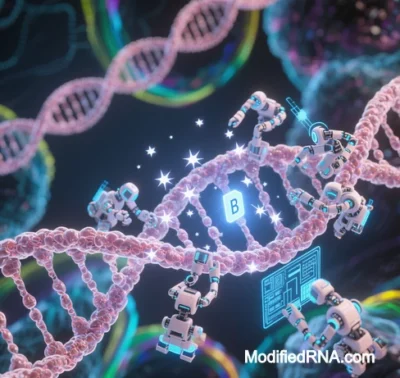
Engineered Modified RNA and Its Biological Significance
Core Technical Strategies for Modified RNA
1. Nucleobase Engineering
- Natural Modification Engineering: Incorporating naturally occurring modified nucleosides (e.g., N1-methyl-pseudouridine, pseudouridine) into mRNA vaccines reduces immunogenicity and enhances translation efficiency. For example, COVID-19 mRNA vaccines using m1Ψ modifications lower immune recognition while tripling protein expression.
- Synthetic Base Expansion: Unnatural nucleotides expand the genetic code, enabling precise modifications in mRNA untranslated regions (UTRs). Light- or pH-responsive bases in UTRs dynamically regulate mRNA stability and translation initiation.
2. Structural Design and Modular Functionalization
- Self-Assembling Nanoparticles: Engineering 5′ caps and poly(A) tails with lipid nanoparticles (LNPs) creates modular delivery systems. GalNAc-LNP systems target hepatocytes with over 90% delivery efficiency.
- Logic-Gated mRNA: Integrating IF/THEN circuits into mRNA enables tumor microenvironment-specific protein expression (e.g., translation triggered only by specific microRNAs).
3. Dynamic Regulation Technologies
- Metabolic Labeling and Tracking: Techniques like scNT-seq with 4sU labeling distinguish nascent and mature mRNA, quantifying dynamic gene expression (e.g., transient Fos/Jun bursts in neuron activation).
- Optogenetic Control: Light-activated CRISPR systems (e.g., PA-Cas9) combined with modified RNA enable spatiotemporal post-transcriptional editing, such as on-demand α-synuclein repair in Parkinson’s models.
Revolutionary Biological Breakthroughs
1. Paradigm Shifts in Genetic Disease Therapy
- Nonsense Mutation Correction: Engineered guide RNAs target premature stop codons (e.g., UAG), restoring CFTR protein function by 70% in cystic fibrosis models through uridine-to-pseudouridine substitutions.
- RNA Editing Over Gene Editing: ADAR-mediated base-editing systems repair point mutations (e.g., HBB E6V in sickle cell anemia) with 95% efficiency, avoiding CRISPR off-target risks.
2. Vaccine and Immunotherapy Advancements
- Immune Evasion Design: m1Ψ-modified mRNA evades TLR7/8 detection, reducing dendritic cell activation thresholds and extending antigen expression to 72 hours (vs. 24 hours for traditional mRNA).
- Personalized Cancer Vaccines: Neoantigen-based modified mRNA vaccines achieve 44% objective response rates in melanoma trials, surpassing traditional peptide vaccines.
3. Synthetic Biology and Cellular Reprogramming
- Programmable Therapeutic Vectors: Modular mRNA carrying suicide genes (e.g., HSV-TK) and immune activators (e.g., IL-12) enables “therapies with built-in monitoring” in glioblastoma, tripling survival in murine models.
- Cell Fate Reprogramming: Optimizing MyoD mRNA with IRES elements and methylation boosts fibroblast-to-myocyte conversion efficiency to 85%.
Technical Challenges and Innovative Solutions
1. Delivery Efficiency Bottlenecks
- Organ-Selective Carriers: Lung surfactant-mimicking LNPs increase mRNA lung distribution to 60%, aiding cystic fibrosis treatment.
- Enhanced Cellular Uptake: Covalent TAT peptide conjugation raises neuronal transfection efficiency to 40%.
2. Precision in Dynamic Regulation
- Machine Learning Optimization: AlphaFold-based models (e.g., Helix-mRNA) predict modification impacts on stability, boosting rational design success rates.
- Quantum Computing Modeling: IBM quantum algorithms simulate mRNA-ribosome binding states, reducing codon optimization time to hours with <5% translation efficiency error.
3. Safety and Ethical Considerations
- Controlled Degradation Systems: miRNA-responsive elements (e.g., let-7) in poly(A) tails trigger mRNA self-destruction during abnormal proliferation, minimizing carcinogenic risks.
- Ethical Safeguards: Blockchain-based GET Matrix ensures GDPR-compliant anonymization and traceability of mRNA therapeutics.
Future Directions
1. Multifunctional RNA Therapeutics
- Diagnostic-Therapeutic Hybrids: Dual-function mRNA with fluorescent reporters (e.g., GFP) enables real-time tumor monitoring in liver cancer models.
- Environment-Responsive RNA: pH-sensitive UTRs and thermoresponsive IRES elements activate apoptosis selectively in acidic tumor microenvironments, sparing healthy tissues.
2. Cross-Species Synthetic Biology
- Microbial-mRNA Symbiosis: Engineered E. coli producing insulin precursors via quorum sensing reduces glycemic fluctuations in diabetic mice by 70%.
- Plant Bioreactors: Chloroplast-produced mRNA vaccines cut costs to $0.5/dose and eliminate cold-chain requirements.
3. AI-Driven Innovation
- Generative AI Design Platforms: GPT-4-powered RNA-SOLVER automates mRNA sequence design for specific efficacy/safety profiles, slashing development cycles from 18 months to 2 weeks.
- Holographic Monitoring: Single-cell spatiotemporal omics and AI digital twins predict patient-specific mRNA metabolism in real time, enabling nanogram-level dosing precision.
Conclusion
Engineered modified RNA transcends traditional “gene replacement” to become a molecular toolkit for precision life regulation. Key biological impacts include:
- Temporal Control: Dynamic modifications enable on-demand gene expression (e.g., optogenetic mRNA).
- Spatial Precision: Organ- or cell-specific delivery exponentially expands therapeutic windows.
- Systems-Level Mastery: Integrating AI and quantum computing solves RNA folding and interaction challenges.
Over the next decade, the field will focus on multifunctional integration, cross-species applications, and ethical safety, ultimately bridging the gap from “treating disease” to “engineering life.”
Data sourced from public references. For collaboration or domain inquiries, contact: chuanchuan810@gmail.com





